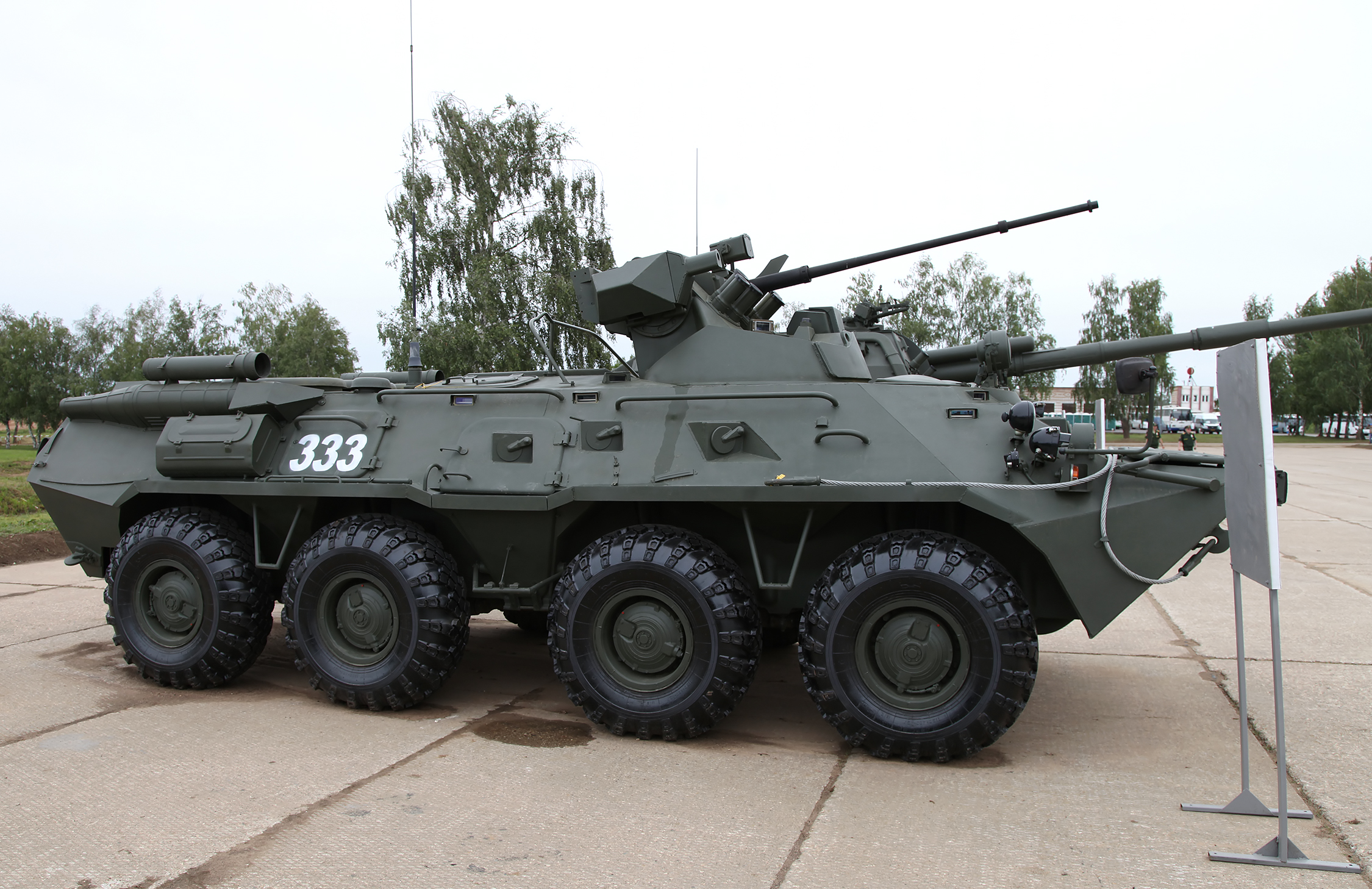Just days after the sighting of several BTR-80 variants among other military equipment bound for Syria onboard the Russian Navy ship Nikolay Filchenkov, an Alligator-class landing ship of Russia's Black Sea Fleet, more advanced Russian-made weaponry has apparently found its way to Syria, with the sighting of BTR-82As being the latest in a series of ill-reported weapon deliveries to the war torn country.
Footage of the Lattakia offensive shows the presence of at least one BTR-82A infantry fighting vehicle (IFV) taking part in the offensive aimed at recapturing previously lost territory in North-Eastern Lattakia. The offensive is conducted jointly by the National Defence Force (NDF), Syrian Arab Army (SyAA) and the Republican Guard, the latter of which only recently deployed to the Syrian Coast in such large numbers. Along with its T-72s, BMP-2s and 152mm 2S3 Akatsiya self-propelled howitzers, the Republican Guard arrived here in mid June 2015. It can be expected that the delivery of BTR-82s to the Republican Guard occured at the same time.
Footage of the Lattakia offensive shows the presence of at least one BTR-82A infantry fighting vehicle (IFV) taking part in the offensive aimed at recapturing previously lost territory in North-Eastern Lattakia. The offensive is conducted jointly by the National Defence Force (NDF), Syrian Arab Army (SyAA) and the Republican Guard, the latter of which only recently deployed to the Syrian Coast in such large numbers. Along with its T-72s, BMP-2s and 152mm 2S3 Akatsiya self-propelled howitzers, the Republican Guard arrived here in mid June 2015. It can be expected that the delivery of BTR-82s to the Republican Guard occured at the same time.
Syria was known to have received a limited number of BTR-80s from Russia in late 2013 or early 2014 under the chemical weapons removal deal, although none of the vehicles tasked with transporting and defending the chemical weapons were ever returned to Russia. The BTR-80s delivered under the chemical weapons deal were all paitned olive drab without any tactical markings. The camouflaged BTR-82A comes with the tactical number ''111''. This opposed to the identification system seen on Syrian military vehicles already in service for longer periods of time.
Deliveries of military equipment to Syria are undertaken by Russian Navy landing ships from the Black Sea to the Mediterranean on a regular basis. Just 3 days ago, on August the 20th, the Russian Navy ship Nikolay Filchenkov passed through Istanbul carrying trucks and armoured vehicles on its deck. The presence of the vehicles on deck was notable, as equipment was previously only carried in the cargo bay and thus out of sight when passing the Bosphorus. This likely means that the batch of vehicles being sent to Syria was so big that it simply didn't fit in the cargo bay alone.
The long-barrelled 2A72 30 mm autocannon easily distinguishes the BTR-82A from the standard BTR-80 armed with 14.5 mm KPVT heavy machine gun. The differences with BTR-80A, an older model with the same 2A72 cannon are of a more subtle nature.
The main difference is the presence of the TKN-4GA-02 night-vision device on top of the BTR-82's turret, replacing the BTR-80's TPN-3 night-vision device. A second identification point is the different exhaust, which can also be seen below.
The recent delivery of BTR-82s to Syria serves as a reminder of Russia's commitment to support the Syrian regime, meaning deliveries of other vehicles and weapons systems are likely in the future. Indeed, Russia's commitment to keeping President Assad in power continues to be greatly underestimated and might be far larger than anyone previously expected.
Deliveries of military equipment to Syria are undertaken by Russian Navy landing ships from the Black Sea to the Mediterranean on a regular basis. Just 3 days ago, on August the 20th, the Russian Navy ship Nikolay Filchenkov passed through Istanbul carrying trucks and armoured vehicles on its deck. The presence of the vehicles on deck was notable, as equipment was previously only carried in the cargo bay and thus out of sight when passing the Bosphorus. This likely means that the batch of vehicles being sent to Syria was so big that it simply didn't fit in the cargo bay alone.
The long-barrelled 2A72 30 mm autocannon easily distinguishes the BTR-82A from the standard BTR-80 armed with 14.5 mm KPVT heavy machine gun. The differences with BTR-80A, an older model with the same 2A72 cannon are of a more subtle nature.
The main difference is the presence of the TKN-4GA-02 night-vision device on top of the BTR-82's turret, replacing the BTR-80's TPN-3 night-vision device. A second identification point is the different exhaust, which can also be seen below.
The recent delivery of BTR-82s to Syria serves as a reminder of Russia's commitment to support the Syrian regime, meaning deliveries of other vehicles and weapons systems are likely in the future. Indeed, Russia's commitment to keeping President Assad in power continues to be greatly underestimated and might be far larger than anyone previously expected.

.png)









